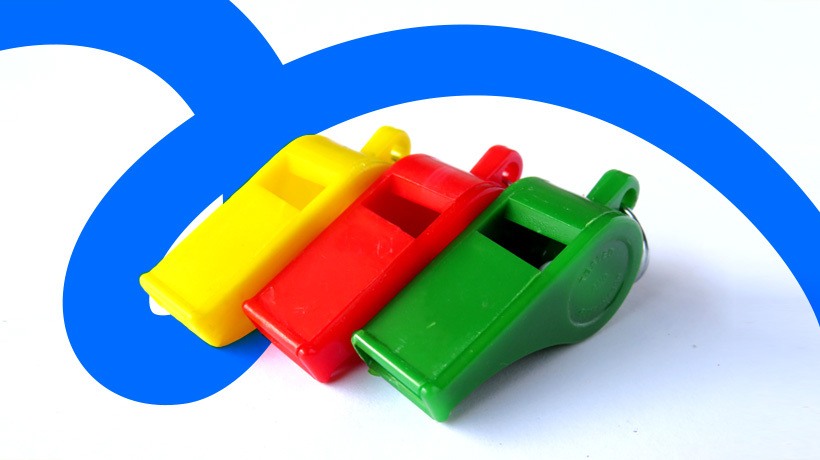Tips To Deploy Employee Coaching Programs In Record Time
There are plenty of reasons to launch employee coaching programs for your remote team. They personalize development and boost staffer engagement. Lower employee turnover is yet another perk, as coaching gives your workforce all the support that they need to face everyday challenges. However, they’re also prepared for uncertain times, like the COVID crisis and all that comes with the new normal. Employee coaching lowers their stress levels and raises their self-confidence, which is a recipe for on-the-job success.
What's Inside This Guide...
- 8 Surprising Perks Of Employee Coaching For Performance Management
- 8 Tips To Ace A Personalized Work Coaching Plan During (And After) The COVID Crisis
- 7 Employee Coaching Activities That Provide Ongoing Support In Uncertain Times
- 7 Social Learning Tools To Incorporate Into Your New Employee Coaching Strategy
- Employee Coaching Template: 8 Steps To Launch A Successful Work Coaching Program
1. 8 Surprising Perks Of Employee Coaching For Performance Management
Employee coaching programs take a targeted development approach. Generally, they involve a short-term action plan. The goal is to bridge specific gaps and improve on-the-job behaviors so that every member of the team lives up to their potential. That said, staffers may continue work coaching throughout their careers. For example, to prep for a promotion or break bad habits they’ve picked up along the way. That’s just a general overview though. The real question is: How can an employee coaching plan benefit your remote workforce? Let’s look at 8 surprising perks of personalized employee coaching programs for performance management.
Reinforce Positive Behaviors
An employee coaching plan doesn’t have to focus on the negatives. Every employee has strengths, such as behaviors or habits that already align with your business needs. But, over time, their performance may start to slip. Employees are so used to work tasks that they just go through the motions, which leads to costly mistakes. Employee coaching programs help reinforce positive behaviors and detect emerging gaps. For example, the work coaching strategy has demos and simulations that prompt self-reflection. Staffers can look at their performance with a fresh perspective. As a result, they continually fine-tune their talents.
Identify Personal Areas For Improvement
There’s always room to improve. Employee coaching programs give staffers the chance to assess their professional know-how. Best of all, it’s discreet. They participate in self-guided online training courses to identify gaps. Then create a plan of action that works best for them. The goal is to help them zero in on pain points in a collaborative setting instead of beating themselves up over minor mistakes on the job because employee coaching gives them a built-in support network.
Personalize Employee Development
Employees should be able to pave their own path, rather than following suit or trying to keep up with peers. Successful work coaching allows them to customize their development whether it’s picking the right JIT support tools or setting the terms of their employment contract. And personalization improves staffer motivation and engagement. They’re more likely to seize new online training opportunities, as they can see how every course or activity fits into the overall plan. For example, they need to complete this certification course to bridge a skill gap. In turn, this will help them boost customer service scores.
Stretch L&D Resources With Work Coaching
One of the common misconceptions about employee coaching is that you need to start from scratch. For instance, develop all new courses and microlearning resources to suit your new strategy. In reality, you can re-purpose existing assets. You can even invite employees to contribute to the online training library to reduce costs. As an example, experienced staffers create demos and tutorials for co-workers. This supplements their formal employee coaching sessions and bridges gaps on the spot.
Build A Stronger Team Dynamic
Every employee plays a vital role in your organization, but they all need to bring their A-game to support the team. If you’re only as strong as your weakest link, negative performance behaviors have a ripple effect. For example, a sales employee doesn’t fulfill their job role, which causes resentment within the department and hurts the team dynamics. Everyone else is doing their part to seal the deal and uphold your brand image. Thus, employee coaching programs can realign teams so that everything falls into place. Nobody is "toeing the line" and the team can work toward common goals.
Improve Employee Retention
Top performers are more likely to stick around if you provide targeted support. Not just courses with a broad overview, but personal employee coaching plans. This leads to a variety of benefits. You don’t have to hire or train their replacements, and you can keep cultivating their talents. Not to mention, work coaching encourages lifelong learning. Staffers are always on the lookout for new online training opportunities, and they know that your organization can deliver.
Reduce Compliance Violations
Costly mistakes are usually related to compliance. For example, an employee forgets to wear the right safety gear and gets injured or they make an error that leads to regulatory fines. Employee coaching programs mitigate these risks, as staffers are able to see the cause and effect of their actions. For example, the first coaching session involves a performance deep-dive. Staffers get to read their job evaluations or simply reflect on recent mistakes. Then they move on to the "why." Why did they make that choice and how they can improve? This entire process is internal. Granted, work coaching assessments or real-world activities are the catalysts.
Reduce Leadership Workload
Many employees turn to managers for help—and that’s perfectly acceptable, within reason. However, work coaching eases the burden on team leadership. Employees can still ask for advice in the workplace, but personalized coaching does all the heavy lifting. For instance, staffers participate in simulations or branching scenarios to build real-world experience so they’re ready to handle job challenges on their own or, at least, make a concerted effort.
2. 8 Tips To Ace A Personalized Work Coaching Plan During (And After) The COVID Crisis
Many organizations are cutting unnecessary expenses and reevaluating their current L&D strategy. However, the COVID crisis makes a personalized employee coaching plan even more essential. Timely and targeted support is just what your team needs, and work coaching preps them for everyday challenges. But how do you give them all the necessary tools on a tight time frame? Your L&D already has a long to-do list or maybe they simply lack the necessary tools and experience. Fortunately, you can hire an eLearning content provider to fast-track your strategy. Here are 8 top tips to ace a personalized employee coaching plan in the COVID crisis.
Consider The Emotional Impact On Your Employees
The COVID pandemic has taken its toll on everyone. If not physically, then psychologically. Thus, you need to consider the emotional impact on your employees to launch successful work coaching programs. How has the coronavirus crisis affected them personally and professionally? What are their current stress levels? How can you develop their talents without adding too much to their workload? Emotional impact also applies to the eLearning content. Every activity should resonate with them and alleviate some of the pressure. For instance, timed simulations or high-stress simulations probably aren’t the best idea.
Make It Discreet And Targeted
Nobody wants to air their dirty L&D laundry. Employees must be able to address areas for improvement discreetly. Furthermore, the personalized employee coaching plan should focus on issues that are within their control, instead of trying to cram too much into each coaching session or online training course. For example, the first round of coaching covers customer service task mastery. After they’ve completed those goals, the staffer moves on to conflict resolution. Ideally, you should avoid coaching activities that pit them against peers. However, you can add gamification to spark friendly competition.
Outsource Employee Coaching Programs To Lighten The Load
You don’t need to develop your personalized employee coaching plan from the ground up. In fact, hiring an eLearning content provider can reduce costs and implementation time, not to mention lighten the load on your L&D team—and that’s just for starters. Employee coaching companies also bring external expertise. They know how to support staffers discreetly and help you achieve business objectives. Another perk is not having to invest in additional software since they have all the necessary online training tools.
Focus On Immediate Goals And Gaps
Peer mentoring involves a more long-term approach. For example, to help employees achieve their career goals. On the other hand, employee coaching programs should focus on short-term gains such as gaps and personal objectives that can improve on-the-job performance right now. In fact, you can use coaching in your mentoring strategy. For example, mentors recommend targeted work coaching sessions to fix performance issues. Think of it as a detour on the road to long-term employee development.
Include Self-Paced Training Resources
Employee coaching programs are collaborative. Whether it involves peers, instructors, managers, or outsourcing partners, that doesn’t mean staffers should feel rushed or that they need to compare themselves against peers. Allow them to go at their own pace and provide personalized online training resources like simulations, branching scenarios, and demos that enrich the experience. Coaches can also recommend relevant resources when employees need a little nudge. As a matter of fact, why not launch a support library. Ask for employee contributions or re-purpose existing materials to fill the virtual shelves.
Let Employees Customize The Coaching Plan
Every member of the team should be in control of their own employee coaching plan. Sure, you provide all the necessary resources and you may even work with them to set a coaching schedule; however, they should be able to pave their own path. For example, choose activities that suit personal preferences, as well as create goals and schedules based on their needs. Ultimately, the coach is there for moral support and guidance, which gives staffers room to grow and achieve their full potential.
Pair Employee Coaching Programs With Peer Support
Employee coaching must be discreet, but peer support is still essential. As an example, staffers can ask questions in social media groups or discussion forums. Otherwise, they have to wait until their next coaching session to clear things up. You should always pair work coaching with peer feedback. Of course, it must be optional. Employees shouldn’t feel forced into discussions or online collaborations. That said, social learning is a great way to bring everyone together and share experiences, and that’s what they need to get through the crisis and build a stronger team.
Gather Employee Feedback
It’s wise to collect eLearning feedback regularly, namely, before, during, and after you launch your strategy just so you can see where your team is at and how to move forward. You can also evaluate the quality of your employee coaching plan. Start with surveys, focus groups, and assessments, or host a live event to make it more personal that way attendees can share their coaching experiences and concerns. For instance, most of your staffers think the online training library needs some work. Maybe it doesn’t facilitate real-world application or it’s outdated.
3. 7 Employee Coaching Activities That Provide Ongoing Support In Uncertain Times
The right employee coaching activities make a world of difference, and it doesn’t have to cost a small fortune. In fact, there are plenty of JIT tools that provide ongoing support for your team, even in uncertain times when stress runs rampant. These bite-sized assets fill gaps and boost employee morale. Of course, every organization has a different work coaching approach. There are unique objectives, spending limits, and personal preferences in play. But some resources are so versatile and engaging that they suit any eLearning strategy. So, consider these 7 employee coaching activities for on-the-spot support.
Weekly Employee Coaching Catch-Ups
Employees get together once a week to share their personal progress and gather feedback. There are usually two ways to approach this. Firstly, your outsourcing partner can host weekly sessions on your behalf or they can set up the infrastructure and hand it over. For example, your managers or instructors host the meetings. However, all the support tools and guidelines are already in place. As a result, they’re able to focus on other aspects of employee development.
Task Simulations With Feedback
One of the most interactive employee coaching examples is task simulations. But you need to follow up with feedback to make it meaningful. For instance, employees participate in customer service simulations that center on interpersonal skills. Then they meet with their peer coach to recap online training performance. It’s also crucial for employee coaching activities to have built-in feedback. On completion, the system displays a high-level overview of areas they need to work on, as well as skills or training topics they excel in. Best of all, employees can revisit these simulations to track their progress.
Social Media Group Discussions
Social media groups give employees a place to exchange ideas and fill gaps on the spot. You can either appoint an in-house moderator or outsource the task. In either case, staffers should have access to resource links. For example, a running list of top-notch tutorials and demos is pinned to the top of the page that way they can make a quick social media pit stop to overcome everyday obstacles. Another reason to launch closed groups is peer coaching. Staffers can chat with co-workers after they complete employee coaching activities and ask for pointers.
Recorded Demos
Employee coaches record demos of tasks or skills in action. Then staffers can watch them whenever the need arises. They’re also a great pre-meeting prep tool. For instance, coaches send links to the demos before the next session. Employees can let all the information sink in and reflect on their own performance and then share their findings during the live event. Maybe they need to work on their negotiation skills to seal the deal or they always skip a step. Video demos set a positive example for them to follow. Another tip is to invite employees to produce their own videos. Top performers can show co-workers how it’s done and common mistakes to avoid.
Employee Coaching Self-Assessments
Looking inward is a crucial part of personal growth. Thus, your employee coaching programs should have knowledge checks, preferably self-assessments that staffers can complete on their own. It empowers them to evaluate performance habits and behaviors. They don’t have to share the results with peers or even their coach. Ultimately, the aim is to motivate and inspire. For example, they score a 75% on their first try. After visiting the JIT library and a few coaching sessions, they raise it to 95%. In short, it creates a benchmark that allows employees to monitor development. They can see that all their hard work is paying off. Even if it takes a little time, they’re gradually chipping away at long-term goals.
Goal Reevaluation Sessions
Goals are tricky because they have to strike a balance. They should be flexible so that employees can adjust as they develop core competencies, but they need to be concrete enough to track and hold employees accountable. So, add regular goal recap sessions to your employee coaching programs. Everyone has the opportunity to look at the current goals and see how far they’ve come and then evaluate how far they need to go to reach the finish line. Of course, lifelong learners always move that line as they get closer. But it’s important for them to note their achievements and get a virtual pat on the back. Small victories lead to big behavioral changes.
Online Training Infographics For JIT Support
Infographics are quick to consume and visually engaging. In other words, they’re one of the most valuable employee coaching activities for JIT support. You can cover virtually any online training topic or task. For instance, every section of the graphic features another step in the process. There are even images that provide a visual example. Another way to use infographics for work coaching is to summarize compliance issues or even company policies and how they relate to job duties. The key is to keep it simple and focus on a single objective. Don’t try to include too much info because that only leads to cognitive overload.
4. 7 Social Learning Tools To Incorporate Into Your New Employee Coaching Strategy
Social learning can help cut costs and boost engagement for your new employee coaching programs. Co-workers can tap into the online community for timely tips and personalized feedback. But how do you incorporate these collaborative tools into your strategy? And, which peer support resources are right for your new recruits? Fortunately, there are plenty of free or low-cost options to choose from so you don’t have to break the bank to facilitate knowledge sharing. The key is knowing how to use these top-notch assets to bridge gaps remotely. Add these 7 social learning tools to your new work coaching plan to maximize ROI and staffer participation.
Social Media Groups
Employees already use sites like Facebook, Instagram, and Twitter every day, even if it’s not for professional purposes. So, why not use this to your L&D advantage. Launch social media work coaching groups to provide on-the-spot support. Everyone can post questions or comments to get online training feedback. Experienced staffers are even able to share resource links that tie into the new employee coaching programs. For example, they stumbled across a great article about negotiation skills. They can share it with the team to spark discussion as well as help co-workers identify personal gaps.
Training Blogs
Blogs are free and easy to use. In fact, every employee or team leader can start their own blog based on their area of expertise. Another option is to create blogs for each employee coaching group. For instance, your sales new hires get their own site to help them onboard and broaden their skills. It’s a great place to upload new online training tools and announce upcoming work coaching events, as well as get their feedback to continually improve your new employee coaching programs. If employees decide to take the reins and launch their own blogs, keep a running list that way co-workers know where to turn for targeted info.
Live Employee Coaching Planning Events
Many employee coaching programs incorporate live events. However, you can also use them to facilitate knowledge sharing among your team. Host smaller events that focus on shared pain points. For example, half of your customer service staffers need help with communication skills, or maybe they’re still unsure about product add-ons or service packages. So, ask their team leader to host a live event to bring everyone up to speed, even the top sales employee can offer their niche expertise.
Video Sharing Sites
Video sharing sites, like YouTube, are like a virtual training library. There are so many videos that cover skill development and positive work habits. Best of all, they’re free. Thus, your team can broaden their horizons without putting a dent in your L&D budget. You can also make this more interactive with follow-up discussions. For example, everyone must watch 5 videos about time management. Then they meet to review what they learned and share personal experiences.
Peer Coaching Forums
A standout perk of new employee coaching programs is that staffers always have a support system. Experienced co-workers can help them overcome obstacles, even if they’re thousands of miles apart. Peer coaching forums are the perfect addition to your work coaching plan because they’re casual. New employees can hop online to ask peers for pointers. Another benefit is moral support. Maybe they’ve had a rough day or feel overwhelmed about their new job roles. They’re able to vent and get sound advice from co-workers. That said, this platform shouldn’t turn into the "complaint corner." Set up some guidelines so that everyone feels comfortable sharing. But personal details and excessive negativity are off-limits. For instance, they can’t post a customer’s name or call out a co-worker.
Breakout Rooms For Personalized Employee Coaching
One of the best employee coaching examples is hosting live events for real-time support. But not everyone wants to share their strengths and weakness in a public forum. This is when breakout rooms step in to provide discreet support. Many video conferencing platforms have this feature. Employees are able to divide into smaller groups and host their own mini-sessions. This is ideal for staffers who struggle with the topic. For example, they don’t understand how the new company policies relate to their job duties, or they don’t quite grasp the new sales process.
Employee-Generated Libraries
Every organization should have an employee contributions library. Staffers get a sense of ownership and reduce online training expenses since they create demos, presentations, and other resources based on their personal expertise. Start with a list of topics you need for the employee coaching library. Then ask your team to develop content and provide them with a list of tools, such as sites they can use for research. It’s best to either assign topics or create a spreadsheet where they add their names that way you don’t have 5 infographics about COI compliance that cover the same ideas. Finally, develop a tip sheet that covers everything from editing to desired length. This makes the QA verification process much more efficient.
5. Employee Coaching Template: 8 Steps To Launch A Successful Work Coaching Program
This employee coaching template isn’t about striving for perfection. Everyone has their flaws, even top performers who’ve been with your organization for years. Sometimes it’s new tasks that trip them up or hidden gaps they’ve overlooked. Work coaching provides them with the personalized resources they need to overcome these obstacles. But it can also help them achieve short-term career goals, like prepping for that big promotion. So, how do you launch a successful work coaching strategy with limited resources? Follow these steps to choose the right outsourcing partner and get maximum value for money.
Fine-Tune Your Work Coaching Budget
How much can you realistically spend on your new employee coaching programs without "borrowing" from other essential business operations, of course? Reevaluate your online training budget and set a spending cap. You can also inventory your assets to look for reusable resources before finding your next custom content provider. For example, repurpose modules or microlearning demos to reduce your employee coaching bill. It’s also a good idea to leave a little buffer for unexpected costs. You never know when those pesky hidden fees will pop up.
Assess Employees To Identify Gaps
Now it’s time to move on to your talent pool. Assess employees to disclose gaps. Then conduct surveys and polls to figure out their goals. In other words, can you help them get from point A to B with employee coaching? This also gives you the opportunity to enhance online training personalization since everyone has different destinations. For example, how can you diversify your work coaching strategy and cater to personal preferences?
Evaluate Your Current Support Library
Take a closer look at your JIT support library. Is there anything missing from the virtual shelves? Do you need to add more resources that complement your new work coaching program? On-the-spot performance support is a crucial part of employee development. As such, you need to budget for additional content whether you’re going to create it in-house or hire an outsourcing partner. If you plan to develop resources internally, plan on authoring tools, video conferencing platforms, and a new LMS on top of the L&D payroll and content curation fees.
Separate Outsourcing Versus In-House Tasks
Ideally, there should be a master budget that’s broken into two sections. The first includes all the in-house tasks and associated costs. The second is all about outsourcing, such as upfront fees, milestone payments, and additional software expenses. This also allows you to determine which solution is more cost-effective. You may realize that some deliverables are more expensive if you create them internally, for example. So, you can move those items to the other side of the list.
Use Online Resources To Find The Right Vendor
Online directories and rating sites are good starting points. You can learn more about a vendor’s background and online training solutions. However, these resources also cover other buying essentials, like support services and customer experience. Just make certain that the listings, reviews, and ratings are credible. For instance, users have to provide basic info and log in through their social media account to leave a review.
Draft Employee Coaching Program RFPs
How do you get spot-on estimates from vendors? The most direct way is to submit RFPs. These requests include all the project details, from price range to support expectations. You should also mention vendor evaluation criteria, proposal deadlines, and contact info that way they can reach out with questions before drafting their response. For instance, they’re unsure about your implementation timeline or deliverables list. Finally, don’t forget to include a follow-up section so vendors can plan accordingly. Should they expect a video conferencing meeting? Is there a test project involved?
Review Proposals
Vendors should submit their proposals before the deadline. If not, give them an email nudge. Once you receive all their replies, host a live review session with your team. This gives everyone the chance to evaluate vendors and narrow the shortlist. You can also develop a scoring system if that streamlines the process. For example, employee coaching programs with one-on-one support automatically receive 5 points. Those with targeted industry know-how get another 10, and so on. Another approach is comparison checklists. Jot down all the pros and cons for each vendor, as well as their price point. Then determine which employee coaching companies offer the best online training ROI.
Finalize The Outsourcing Contract
That brings us to the last step in the employee coaching template, which is contract negotiations. That’s right, everyone’s favorite part of the process! It doesn’t have to be stressful though so long as you communicate with the vendor and get everything in writing. You might consider setting up a meeting to discuss the terms or even prepare a list of questions after you review the agreement. Make certain all the payments, deliverables, and time frames are clear. When in doubt, ask for legal advice before signing on the dotted line. And feel free to ask the vendor for revisions if something seems out of place.
Conclusion
One-size-fits-all support simply won’t do in today’s corporate world. Every member of the team has their own preferences and pain points. Hiring employee coaching companies can help build their self-confidence and tackle any challenge. They don’t have to struggle with new tasks and emerging gaps, as work coaching gives them all the tools that they need to handle the new normal and manage stress levels. Best of all, you can outsource employee coaching to reduce development time and stretch resources.
Download the eBook Employee Coaching Programs: How To Launch A Successful Work Coaching Strategy On A Tight Timeframe to boost employee performance and achieve your L&D objectives.








